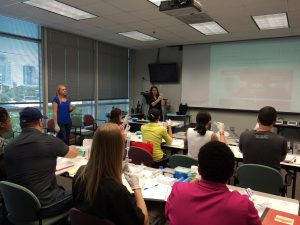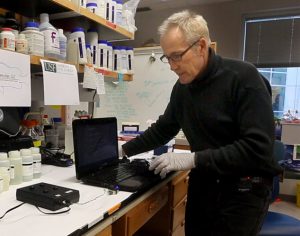Citizen volunteers and college students are evaluating an NCCOS-funded portable sensor that easily and accurately calculates the number of Karenia brevis cells in a water sample, the algae that causes red tides in Florida. This month, St. Petersburg College biotechnology students learned how to use the sensor in a training class at the University of South Florida (USF) Knight Oceanographic Center in St. Petersburg, Florida.


St. Petersburg College students withDr. Michelle Osovitz's "Methods and Applications in Biotechnology" class practice the RT-NASBA protocol prior to running their samples through the portable mRNA amplifier. Credit: J. Wickham, NOAA.
The NCCOS project, led by the USF College of Marine Science, is developing a genetic sensor to accurately quantify red tide abundance. The sensor calculates the amount of ribonucleic acid (mRNA) in a single gene specific to the red tide alga Karenia brevis. The technique is based on the genetic assay technique called real-time nucleic acid sequence-based amplification or RT-NASBA. A portable commercialsensor converts the RT-NASBA data to cell counts in the lab or in the field. A cell phone application can provide instant transfer of the red tide monitoring data to state management agencies and the Gulf of Mexico Coastal Ocean Observing System.

Dr. John Paul, inventor of the Karenia brevis RT-NASBA application, runs purified K, brevis mRNA in an amplifier calibrated to convert mRNA to cell counts. Credit: USF College of Marine Science.
In Florida, citizen volunteers help the Florida Fish and Wildlife Research Institute (FWRI) and the Mote Marine Laboratory (MML) monitor more than 100 locations weekly, twice-monthly, or monthly to detect nuisance, harmful, and toxic algal blooms, including K. brevis. Led by the FWRI, these data are made available to the public and reported to government management partners who make decisions about shellfish bed closures and beach warnings to mitigate the harmful impacts of algal blooms. Currently, FWRI uses light microscopy to enumerate K. brevis, a highly skilled, labor intensive process. Extensive training is required to distinguish K. brevis from closely related, morphologically similar and non-toxic Karenia species.
By contrast, the easy-to-learn RT-NASBA assay can be performed in 60 minutes with a high degree of accuracy and little potential for cross-reactivity from non-target species and offers a real-time identification system relative to the current light microscope method.
Small groups of citizen volunteers affiliated with FWRI and MML are being trained initially, with larger and more formal training sessions planned. Expansion of the sensor technology to other Gulf of Mexico states is being considered.
For more information, contact John.Wickham@noaa.gov.
 Official websites use .gov
A .gov website belongs to an official government organization in the United States.
Official websites use .gov
A .gov website belongs to an official government organization in the United States. Secure .gov websites use HTTPS
A lock or https:// means you’ve safely connected to the .gov website. Share sensitive information only on official, secure websites.
Secure .gov websites use HTTPS
A lock or https:// means you’ve safely connected to the .gov website. Share sensitive information only on official, secure websites.